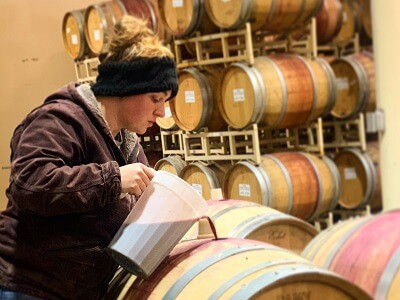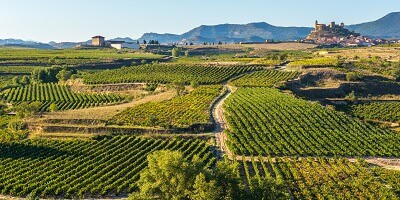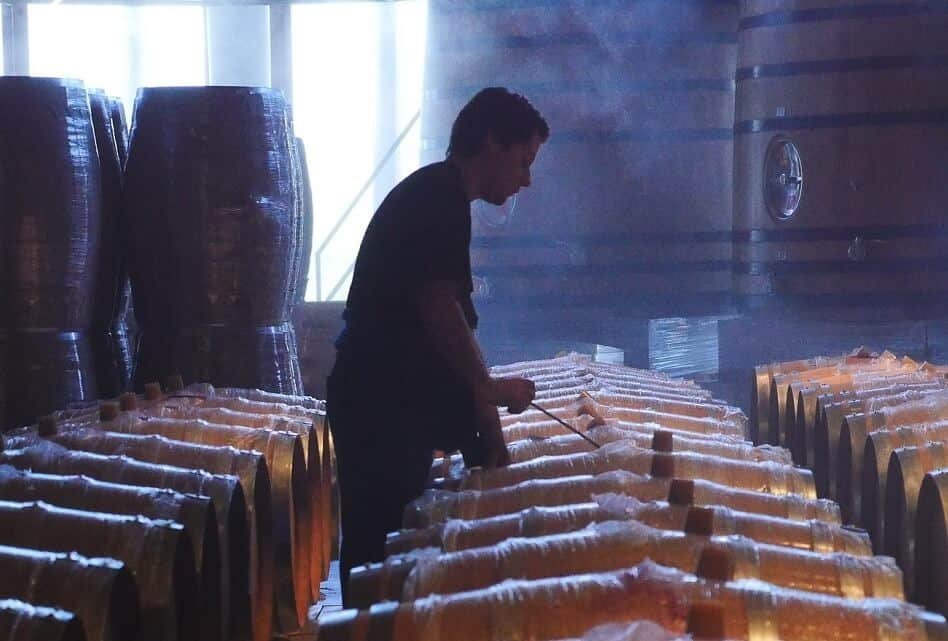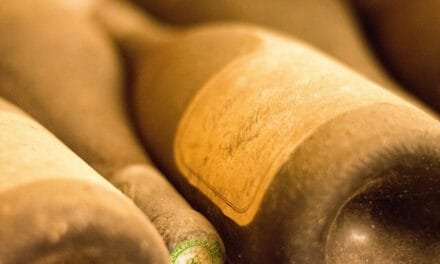Winemakers use thousands of different grape varieties to make their delicious beverages. And as a wine lover, you probably know some of these varietals. But do you also know that many wines are made of more than one grape type? Actually, wine blending is very common, and it produces some extraordinary great wines.
Wine blending is the process of combining wines made of different varietals or in different years. Its goal is to create a wine that is better than its single ingredients. Blends are very common in the world of wine, and many great wines are blended.
To understand why winemakers blend wines and how they do it, let us discuss the details on blending wine.
REASONS FOR BLENDING WINE
The goal of wine blending is to create a wine that is better than the wines used as ingredients. It is important to understand that the ingredient wines are already good, though. So blending is not about making a bad wine good, but making a good wine better.
Typically, vintners have a very clear idea about how to improve their wines. They know exactly which wine characteristics they want to alter and how they can achieve this goal. These are the major reasons for blending wine:
- add more aromas to create a more complex flavor profile
- increase or decrease the alcohol level (which alters the wine’s body)
- optimize the level of acidity, sweetness, or tannins
- improve the wine’s color
DIFFERENT TYPES OF WINE BLENDING
To create the perfect wine, vintners use different wine blending approaches. We can distinguish, in particular, two types:
- By blending wines made from different varietals, vintners can combine their characteristics. For instance, they can use Cabernet Sauvignon or Syrah wines to add body to a rather light wine.
- Combining wines from different vintages is the second common way of blending. Among other reasons, this practice is beneficial to even differences in taste and quality caused by unstable weather conditions.
Especially producers of fortified wines often combine these two approaches. They blend wines from different varieties as well as from different years to create optimal results.
WHICH GRAPES ARE USED FOR WINE BLENDING?
In theory, vintners can use all grape varieties, red or white, for wine blending. It is rather uncommon to blend reds with whites, though. Usually, winemakers blend reds with reds and whites with whites.
Varietals differ in terms of how easy it is to blend them:
- Some grapes only tolerate small additions of other varieties. When blended with too much other wine, they can be overwhelmed and lose their characteristics. Sangiovese, Pinot Noir, Zinfandel, and Riesling belong to this category.
- Other grape varieties like Cabernet Sauvignon or Syrah are more dominant. They can stand their ground and let their characteristics shine even if large portions of other wines are added.
HOW IS WINE BLENDED?
Vintners need years of experience to master wine blending and create the best blends from the grapes they have at hand. To find the optimal combination of wines, they use two means: technical analysis and tasting.
The technical analysis focuses on the wine characteristics that are quantitatively measurable, in particular, acidity, sweetness, and alcohol levels.
Acidity Level
The acidity level determines how crisp a wine tastes. Winemakers can quantify it by measuring the TA level (total acidity level) or the pH level (power of hydrogen level).
The TA level describes the amount of acidity as a volume percentage. So the higher the TA level is, the more acidic the wine is. Most wines have a total acidity level of 0.6 to 0.7%.
The pH scale ranges from 0 to 14, with 7 being neutral. Liquids with a pH value lower than 7 are acidic. That also means that wine with a low pH value is more acidic than wine with a high pH value. Typically, white wines range between 3.0 and 3.4, while reds range between 3.3 and 3.6.
Sweetness
A wine’s sweetness depends on the level of residual sugar (short: RS) that it contains. The more residual sugar is in the wine, the sweeter it tastes. To determine the RS value of their wines, vintners can use different testing kits.
But they can also determine the sweetness of grapes before fermenting them. That helps find the best time for harvesting, so the single wines have the optimal sweetness before blending them.
For the latter purpose, winemakers use a refractometer that measures the refraction of light passing a liquid sample. Vintners crush one or two grapes and check their juices. And the refractometer quantifies the juice’s denseness as degrees Brix (short: °Bx), which allows a conclusion to the wine’s sweetness: The higher the °Bx value, the higher is the juice’s denseness and the more sugar is in it.
Alcohol Level
The alcohol level contributes to the wine’s body. The higher it is, the bolder and more powerful the wine.
Winemakers can determine the alcohol level by comparing the wine’s denseness (respectively, the juice’s denseness) before and after fermentation. A refractometer is not the proper tool for this purpose because it does not work correctly with liquids containing alcohol. The reason is that alcohol itself affects light refraction.
Instead, vintners use a hydrometer. It measures the liquid’s specific gravity (short: SG). When the sugar turns into alcohol during the fermentation, the wine’s specific gravity decreases. And by comparing the SG before and after the fermentation, the vintners can calculate the alcohol level at the end of the process.
Flavors, Complexity, and Balance
While acidity, sweetness, and alcohol levels are quantitatively measurable, other wine characteristics are not. It is impossible to express the different flavors and aromas, the wine’s complexity, and its balance in numbers. Instead, vintners evaluate them based on personal perceptions and preferences. Or in other words: They taste the wines and compare them to other wines.
HOW WINEMAKERS FIND THE BEST WINE BLENDING RECIPE
After measuring and judging their wines, vintners proceed by creating different blends. They take small quantities of the single wines and blend them. For each blend, they use slightly different shares of each wine. For instance, they might combine:
- 4 parts Cabernet Sauvignon and 1 part Merlot
- 4 parts Cabernet and 2 parts Merlot
- 3 parts Cabernet and 1 part Merlot
- 3 parts Cabernet and 2 parts Merlot
Then, they sample the different blends and determine which they like best. As soon as they have found the optimal recipe, they proceed with all of the wines they have produced yet.
Be aware that this is just a theoretical example. In reality, the setup might be much more complex and include multiple rounds of wine blending and tasting. Also, there might be many more than just two wines involved. To find the best recipes, some winemakers go through dozens of different recipes.
WHEN IS WINE BLENDED?
Typically, wine blending happens late in the production process. Vintners grow, harvest, ferment, and age the different grape varieties apart from each other. It is not uncommon that they even come from different vineyards and don’t get close to each other until they reach their optimal flavor profile. Vintners then test (and taste) them separately and decide how to proceed. After determining the optimal recipe, they blend the wine. Soon after completing the blending, the wine is ready for bottling.
Some vintners follow other wine blending practices, though. They mix their wines halfway through the aging process or even let them ferment together. These approaches are neither better nor worse. What works best depends on the vintners’ personal preferences and experiences.

Blends Wine During the Aging Process
Source: @SerranoWine, Twitter
Field Blends
A couple of vintners even start the wine blending process before the harvest. They cultivate multiple different varietals in the same area. So a Tempranillo vine might grow right next to a Petite Sirah vine. As there is no limit to the number of varietals, some winemakers plant dozens of different grapes in their vineyards. They even mix red and white grapes in the same lots.
Because of this variety of vines, it is fair to say that the wine blending happens in the vineyard. Consequently, wine lovers call this practice “field blending” and the resulting wines “field blends”.
All of the grapes are harvested and processed together at the same time. The resulting wine’s characteristics are hard to predict because they depend on the share of varietals and their ripeness. However, some wine experts claim that “field blends reach another level of complexity, balance, and elegance that is very difficult to reach in blended wines.”
ARE BLENDED WINES INFERIOR?
Blended wines are not inferior to non-blended wines. As the purpose of wine blending is to improve the wine, most blended wines are quite good at least. In some cases, they are even better than single-varietal wines. However, it is not possible to judge wines solely based on whether they are blended or not. You can find both excellent pure wines and great blends.
GREAT WINE BLENDS
Many blended wines are not only good; they are excellent. And some of them are world-famous. So let us discuss the best red and white results of wine blending.
Bordeaux Wines
The vast majority of red Bordeaux wines are blended. These powerful, concentrated wines that wine lovers worldwide love are made from at least two, in some cases more varietals.
But Bordeaux winemakers cannot use all grapes to produce them. Only six varieties are allowed: Cabernet Franc, Cabernet Sauvignon, Carmenere, Malbec, Merlot, and Petite Verdot. In the Left Bank of Bordeaux, which is home to famous appellations such as Haut-Médoc or Sauternes, Cabernet Sauvignon is the predominant grape in most blends. Here are some examples:
- type: red, still, Vintage
- origin: France, Bordeaux (left bank)
- varietal: Cabernet Franc, Cabernet Sauvignon, Merlot, Petit Verdot
- alcohol: 13.5%
- type: red, still, Vintage
- origin: France, Bordeaux (left bank)
- varietal: Cabernet Franc, Cabernet Sauvignon, Merlot, Petit Verdot
- alcohol: 14.0%
- type: red, still, Vintage
- origin: France, Bordeaux (left bank)
- varietal: Cabernet Sauvignon, Merlot
- alcohol: 13.0%
Wines from the Right Bank with appellations like St. Emilion and Pomerol typically feature Merlot as the primary variety. Try one of these wines to get an idea of Right Bank Bordeaux:
- type: red, still, Vintage
- origin: France, Bordeaux (right bank)
- varietal: Cabernet Franc, Cabernet Sauvignon, Malbec, Merlot
- alcohol: 15.0%
- type: red, still, Vintage
- origin: France, Bordeaux (right bank)
- varietal: Cabernet Franc, Cabernet Sauvignon, Merlot
- alcohol: 14.0%
- type: red, still, Vintage
- origin: France, Bordeaux (right bank)
- varietal: Cabernet Franc, Cabernet Sauvignon, Merlot
- alcohol: 14.5%
Most white Bordeaux wines are the results of wine blending, too. These fresh, light-bodied wines are made from varietals like Semillon, Sauvignon Blanc, and Muscadelle.
Meritage Wines
The techniques and traditions of Bordeaux winemakers are valued by many vintners outside of France. Some of them formed an organization called The Meritage Alliance that is dedicated to producing high-quality blended wines. As Bordeaux is a protected wine appellation, they had to come up with a new name, though: Meritage. The term is a combination of the words merit and heritage.
Just like Bordeaux wines, Meritage can be either red or white. In any case, it has to be a blend. Vintners use the very same grapes as their French colleagues, and carefully combine them to make dry, full-bodied wines. They feature intense fruit flavors as well as herbal, earthy, and oaky notes.
GSM Blends
The Southern Rhône Valley in France is home to a blend adapted by other winemakers around the world: the GSM blend. GSM stands for Grenache, Syrah, and Mourvèdre. These three grape varieties are the most important in the region. Local vintners blend them with each other and with other varietals to create rich, full-bodied red wines. And each varietal has a specific purpose:
- Grenache contributes red fruit aromas, spicy notes, and alcohol.
- Syrah adds structure and black fruit notes.
- Mourvèdre brings tannins and color to the mix.
These bottles are great examples of French GSM blends:
Domaine du Vieux Telegraphe Chateauneuf-du-Pape La Crau 2019
- type: red, still, Vintage
- origin: France, Rhône Valley
- varietal: Cinsault, Grenache, Mourvèdre, Syrah
- alcohol: 14.5%
Chateau Fortia Cuvee du Baron Chateauneuf-du-Pape 2018
- type: red, still, Vintage
- origin: France, Rhône Valley
- varietal: Grenache, Mourvèdre, Syrah
- alcohol: 14.5%
Guillaume Gonnet Chateauneuf du Pape Bel Ami 2019
- type: red, still, Vintage
- origin: France, Rhône Valley
- varietal: Cinsault, Grenache, Mourvèdre, Syrah
- alcohol: 14.5%
Chiantis
Chianti is a red wine blend from the Tuscany region in Italy. Its main ingredient is Sangiovese, a local grape that produces medium-bodied wines with firm tannins, lively acidity, and intense fruit aromas. According to Italian wine laws, Chianti must contain at least 70% of this variety. The rest can be other red varietals such as Cabernet Sauvignon or Merlot. Vintners also use other native grapes like Canaiolo Nero and Colorino, and in some cases, white varieties, too.
Try one of these wines to get the iconic Chianti taste:
- type: red, still, Vintage
- origin: Tuscany, Italy
- varietal: Sangiovese
- alcohol: 13.0%
- type: red, still, Vintage
- origin: Tuscany, Italy
- varietal: Sangiovese, Merlot
- alcohol: 13.5%
Santa Cristina by Antinori Chianti Superiore 2017
- type: red, still, Vintage
- origin: Tuscany, Italy
- varietal: Sangiovese
- alcohol: 13.0%
Chianti Classico comes from the same region but is subject to stricter regulations. Sangiovese must be the primary varietal, but at an even higher portion: 80% or more of Chianti must be Sangiovese. While other red grape varieties may be used for the other 20%, white grapes are prohibited.
These bottles are worth opening:
Bindi Sergardi Calidonia Chianti Classico Riserva 2015
- type: red, still, Vintage
- origin: Tuscany, Italy
- varietal: Sangiovese
- alcohol: 14.5%
Poggio Bonelli Chianti Classico Riserva 2016
- type: red, still, Vintage
- origin: Tuscany, Italy
- varietal: Sangiovese, Canaiolo, Merlot
- alcohol: 14.0%
Brancaia Chianti Classico Riserva 2017
- type: red, still, Vintage
- origin: Tuscany, Italy
- varietal: Sangiovese, Merlot
- alcohol: 14.0%
Super Tuscans
There are more wines from the Tuscany region that we should include in our discussion about wine blending: Super Tuscans. In many cases, they come from the same areas as Chianti wines, but they don’t meet the strict requirements that are necessary to carry the Chianti label. However, that doesn’t mean that they’re inferior to their cousins.
Just like in Chiantis, Sangiovese plays an important role in Super Tuscans. It doesn’t have to be the primary varietal, though. In some wines, it only contributes only as little as 25% to the blend. And in others, it might be missing entirely. Other varietals that winemakers blend for their Super Tuscans are, among others, Cabernet Sauvignon, Cabernet Franc, Merlot, or Petit Verdot.
Tenuta Guado al Tasso Il Bruciato 2020
- type: red, still, Vintage
- origin: Italy, Tuscany
- varietal: Cabernet Sauvignon, Merlot, Syrah
- alcohol: 13.5%
Tenuta Le Colonne Bolgheri 2019
- type: red, still, Vintage
- origin: Italy, Tuscany
- varietal: Cabernet Franc, Merlot, Petit Verdot
- alcohol: 13.5%
- type: red, still, Vintage
- origin: Italy, Tuscany
- varietal: Cabernet Franc, Cabernet Sauvignon, Merlot
- alcohol: 14.5%
Rioja Wines
The Rioja region is located in the Northeast of Spain. It is one of only two appellations with DOCa status, which is the highest quality label for Spanish wines. Rioja is famous for its red wines with medium to full body, robust tannins, and intense fruity flavors.
The main ingredient in Rioja wines is Tempranillo. It is blended with other native varietals like Garnacha, Graciano, Mazuelo, or Maturana Tinta.

Rioja Wine Region
La Rioja Alta Gran Reserva 904 Tinto 2011
- type: red, still, Vintage
- origin: Spain, Rioja
- varietal: Tempranillo
- alcohol: 13.5%
La Rioja Alta Vina Ardanza Reserva 2012
- type: red, still, Vintage
- origin: Spain, Rioja
- varietal: Tempranillo
- alcohol: 14.5%
Torre de Ona by La Rioja Alta Reserva Finca Martelo 2014
- type: red, still, Vintage
- origin: Spain, Rioja
- varietal: Mazuelo, Tempranillo
- alcohol: 14.5%
Port Wines
Wine blending is an important technique for making fortified wines, too. Port wine, for instance, comes in many different styles, most of which are blends. And Portuguese vintners blend not only different varietals. They also blend wines from different years (= vintages) to optimize the final product’s taste.
The most important red grapes for Port wine blending are Touriga Nacional, Touriga Franca, Tinta Barroca, and Tinta Roriz. White grapes such as Sercial, Malvasia Fina, or Verdelho are the dominant varietals for the production of white Port. In total, there are about 80 different varieties that can be used, and many of them are unique to Portugal.
These Port wines are good examples of Portuguese wine blending traditions:
- type: red, fortified, sweet
- origin: Portugal, Douro
- varietal: Touriga Francesa, Touriga Nacional, Tinta Amarela, Tinta Barroca, Tinta Cão, Tinta Roriz
- alcohol: 20.0%
- type: red, fortified, sweet
- origin: Portugal, Douro
- varietal: Tinta Barroca, Touriga Francesa, Touriga Nacional
- alcohol: 19.0%
- type: white, fortified, sweet
- origin: Portugal, Douro
- varietal: Arinto, Côdega de Larinho, Gouveio, Rabigato, Viosinho
- alcohol: 19.5%
Commandaria Wines
Another fortified wine that is the result of wine blending is Commandaria. It comes from Cyprus, a small insular state in the Mediterranean Sea.
Commandaria is a very interesting example of wine blending because it is made from one white and one red varietal. After the harvest, vintners lay the grapes out in the sun to dry them for up to three weeks. When they finally press them, their juice is incredibly sweet. After fermenting, fortifying, and extensively aging the wine, it is a strong, sweet wine with highly concentrated aromas of dried fruits, honey, and caramel.
FINAL WORDS
Blended wines are very common, and there is no reason to consider them inferior to pure varietal wines. With the details from this article, you’re able to understand the purpose of wine blending and also to find excellent wine blends. Now it’s time for the practice: Get yourself a bottle of blended wine and a varietal wine and compare them to each other. Which one will you like better?






